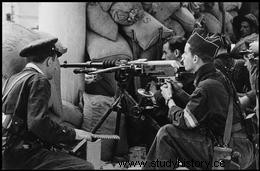
Franco placed all forces on the Madrid front under the command of General Mola, a former comrade-in-arms alongside whom he had fought in Morocco twenty-four years earlier. Mola set up his headquarters in Avila, 110 kilometers from Madrid. Franco, Varela and Mola had to choose between a militarily correct solution—reinforcing themselves before unleashing a pincer attack from both the north and the south—and a daring maneuver in which they risked everything and gave the 'assault the city as soon as it came within cannon range.
In view of the growing increase in Soviet aid, intelligence of an international volunteer force s' dragging in the vicinity of Albacete and signs of disappointment shown by the Germans and Italians, as the war dragged on, the nationalist leaders opted for the risk.
The third and most powerful assault against Madrid was launched on November 1, 1936. General Mola gave a press conference during which he presented the personalities who would constitute the future civil administration of the capital as of November 7. "To celebrate the Bolshevik Revolution," he added jokingly. On November 4, Getafe airport, located just 13 kilometers from Madrid, fell into the hands of the nationalists.
The fall of Getafe was preceded by a sinister episode which gave a foretaste of what was to happen a few years later, during the Second World War:the terrible aerial bombardment of October 30 during which at least 60 children found the dead. On November 6, two days after the fall of Getafe, the German Condor Legion assembled in Seville. In autumn 1936 it comprised 10,000 men, its maximum strength, and had an air force of 48 bombers and 48 fighters. Thus, part of the German air force, the future executives of the Luftwaffe, those who were to make the principles of the Blitzkrieg triumph in 1939-1940, had the opportunity to experiment against the Spanish people with a new style of war.
After the fall of Getafe, Radio Burgos broadcast a program called "Madrid's Last Hours". The next day. on November 5, Radio Lisbon announced in world exclusivity the entry of General Franco on his white horse into the Spanish capital. On the same day, Nationalist forces moved in from the south and reached Madrid's tram and bus terminals. The bombardment intensified and leaflets were dropped advising Madrid residents to stay at home until the city was liberated, and announcing that only the "guilty" would be punished. At the same time, truckloads of food were being assembled behind the artillery lines.
In the Republican camp the government was reshuffled, including for the first time anarchist ministers, notably the Minister of Justice. On November 6, the day before the strongest nationalist attack, the government quietly reached Valencia in private cars and the command of Madrid was given to the old general Jose Miaja. He had been chosen, along with a group of junior commanders, to oversee the terms of the surrender. General Varela was delighted. “We will easily defeat this old grandfather. He was wrong.
The morale of the militiamen defending the center of the city was beyond low due to lack of sleep, incessant bombardments, flight from the government and hunger:they had not eaten for forty-eight hours. Some sectors were running out of ammunition and gunners were reporting that they had only a few shells left.
At 6 a.m. sharp on November 7, all Nationalist guns within Madrid opened fire on carefully chosen targets. A daring push of two columns progressed between the Plaza de Esparia and the University City. Each column included 1,250 men, 500 Moroccans from the regular army, 600 Spanish soldiers from the Foreign Legion and engineer soldiers from the African Army. One was backed by a 105 battery, the other by a 75 battery.
